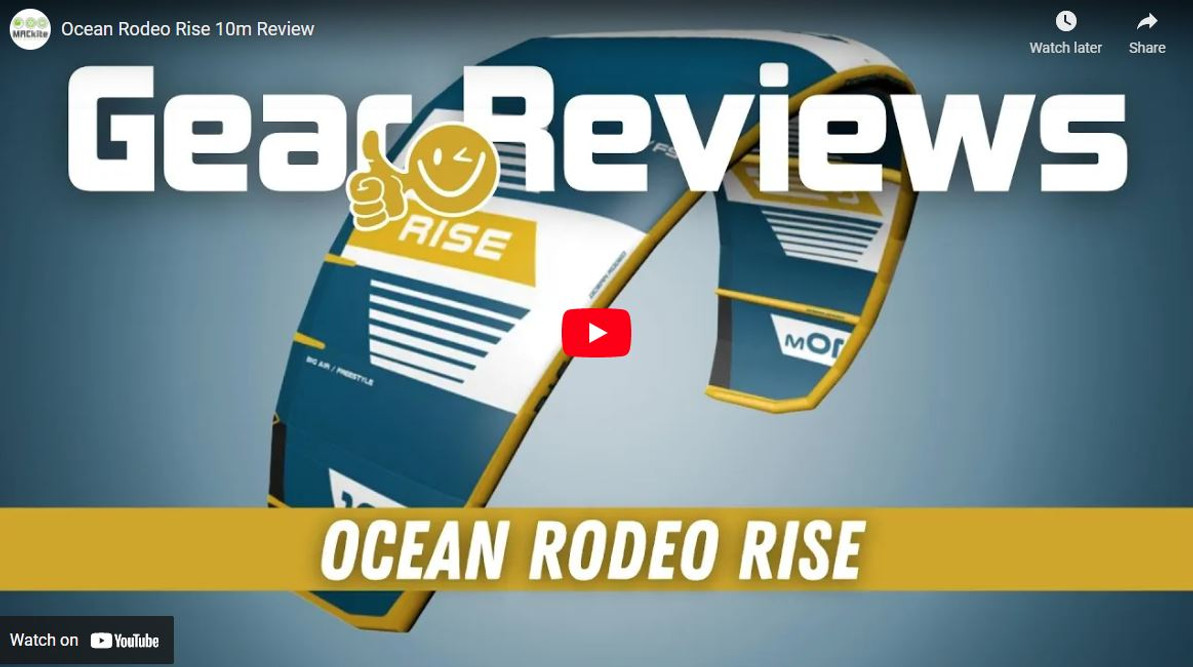Ocean Rodeo Rise 10m Review
What's up, guys? Rygo here from MACkite. We just got into Hatteras. We spent the whole winter testing gear down in Florida, hanging out in central Florida, riding in the Keys, and now we're up here in the Outer Banks and finally getting some stronger wind, so I had the chance to get out and test the 10 meter Ocean Rodeo Rise, and this kite very much surprised me. It is kind of higher aspect, but it is a big air kite. I've been testing quite a few of the higher aspect big air kites, and this one is completely different from the rest. There are some things that I think are really good about this kite, there are some things that I didn't like about this kite, and I think there is a very specific rider who is going to benefit most from this kite, so we'll break all that down in this video.
With the Ocean Rodeo Rise, what you're getting is a unique blend of a higher aspect, loftier, big air kite, but where this one really stands out is in the kiteloops. By far, this is the best high aspect kite that I have ever kitelooped in my life. I have tested quite a few 10 meters now, and depending on the 10 I get on, sometimes I feel good about throwing a loop, and sometimes I don't. This is going to sound like one of those sales pitches, but I swear that 10 looped like a 7. I have never felt better about looping a 10 meter, and it's like a hammer. When you pull that trigger, it's over before you realize it, and it was almost reminiscent of how a surf kite loops.
I think part of the design with some of these big air kites like the Rise is it is made to be ridden lit. I am about 190 pounds and I took the 10 meter out in probably 22 to 32, so it was variable and very gusty. When you're riding this in the conditions that you would ride a normal 10 meter in, I think there's a huge advantage to somebody who is trying to work on kiteloops because it is so fast and the catch is so eminent. I think I had a few jumps where I was only a meter or two off the water and the freaking thing caught me... unreal! It's just so fast. But what was interesting is when you're riding the 10 meter Rise in the conditions that you might normally ride a 10 meter in, the loops are kind of mild, very much like a surf kite. It's very fast and there's a little bit of whip, but I didn't feel like my legs were going to get thrown. This sets up that intermediate rider who's looking to get to competition level for success because you can get super comfortable with loops and then train a lot of those big air moves without all of the g-force or getting as beat up in super strong conditions.
With that said, this kite is made to be ridden powered, so when you are looking to take it to that competition level, when you are that advanced rider, the kite handles being lit so well. This was really noticeable on the water. I have been out on plenty of nine meter kites when the wind was like 25 knots and they felt pretty good, and this one also felt good, but the kite really came to life once it was getting closer to the 30-something mark and it had what a big air rider would be looking for as far as the extremes of kiteboarding.
Coming into some of the the cons, unlike some of the other high aspect kites that I've been testing, like the Lithium or the Machine, this one is not forgiving. If you're not a more intermediate rider, it is easier to mistime your jumps and, while riding in the chop, I did find there were a few times where I botched it and only got a couple feet off the water, and that just doesn't happen that often on the other kites. I've previously mentioned how the Lithium or the Machine, both high aspect big air kites, make bad conditions so easy, and for somebody who is new to big air there's huge benefits with those kites because it's pretty hard to mess up a good jump and you'll get good height and good loft with them.
The Rise also has extremely light bar pressure, and you'll know that you're powered when you feel a little bit of that bar pressure turn on, but otherwise it's feather light. I think they designed it that way so that when you're riding powered you're not going to get forearm fatigue because the kite doesn't have strong bar pressure, so that has to be intentional for what they made this for, but one of the cons of that feather-light bar pressure is that will make it harder for a newer rider. When I say feather-light, I mean that I have not in a very long time been on a kite where, mid-backroll, I have zero sense of where the kite is. I accidentally pulled the trigger and looped the kite and, because it is so fast and such a hammer-like loop, it caught me off guard and I just got smoked a few times. It took me probably a good half an hour to get in tune with it because, while there is response and feedback, it's just so light and feathery on your fingers that when you first get out there, you're going to have to get that dialed in. When you're in more sketchy conditions like where I was--super chop, super gusty wind--I wasn't very comfortable trying a lot of the things that I normally like to do on kites where I do have that feedback.
One of the pros to having one of the more forgiving big air kites that might not loop as well is, if you're somebody who's working on something like a late backroll, after the loop you usually bring the kite forward so you can counter rotate to throw that roll. That's definitely doable with the Rise, but you need to get in tune with that feather-light bar pressure so you can feel that and place the kite where you want. Having a sense of where the kite was so I could place it where I needed it when I was in the air while not looking at the kite was one thing that I struggled with.
With all that said, more experienced big air riders tend always to be watching their kite. I know one of the tips with kiteloops is to watch that center strut and watch the kite come up, so if you're watching the kite, that's going to definitely be a saving grace with the Rise, but that comes back to the beginner versus the intermediate rider. Intermediate riders... man, you are going to love this kite, and I think that's who this is aimed at.
If you're somebody who has been riding for a while and you want to take your loops to the next level, or even if you're somebody who just wants to learn kiteloops, I think this is an exceptional kite. If you're that rider who's trying to learn kiteloops, you're going to take a small hit by losing some of that forgiveness and some of that feedback for doing tricks and things, but the feedback is there and you will get acclimated to the kite to the point that you can feel that bar pressure. Still, there will be a learning curve and you're going to pay the price. This is common when you move to more advanced gear, and I would make the case that if you're somebody trying to get to the next level, these trade-offs are well worth it. It's always well worth it when you're going for a specific kite for your discipline, and the Rise has got to be one of my favorite kites I've ever tried to loop. I went out there and it was just loop, loop, loop, and a huge smile on my face.
On to other considerations, I would say this kite probably has eighty percent of the loft of some of the other big air high aspect kites that I've flown. The loft is there and you do get extra loft by working your kite, but because there was less feedback it wasn't as intuitive for me to work my kite, so I think that was part of the loss. But it's made to be powered, so with the conditions that I took this 10 meter out in when I had ample wind, in the upper 20s - 30s, yeah, there was feedback. It felt super lofty then, very similar to the other high aspect kites. When I was on the lighter end, down to 22 - 25, the loft just wasn't there compared to the other high aspect kites that I've used in similar sizes.
That pretty much sums up the Rise. It's aimed at that intermediate to advanced rider who wants to learn kiteloops easily and then have the right tool to go out in nuking conditions and just freaking get blasted because, when you are powered on these kites, the loops really come alive. You start feeling those g-forces from the kite, and it is the right tool for that rider who wants to get to a competitive level or just send it.
The only person that I think this would not be a great choice for is somebody who is new, or if you're not super comfortable doing all of your rolls with all of your grabs, or maybe you're just starting to do late backrolls and things like that. It's going to be a bit more of a learning curve because you're making those trade-offs for the very advanced loops. A huge plus that I really liked was that light bar pressure. It's going to save you that forearm burn when you're out riding in lit conditions, but you are taking the hit with less feedback.
If you have any questions on the Rise, let me know in the comments. If you found the video helpful, give it a thumbs up, hit that subscribe button, and I'll catch you later.

Recent Posts
-
How to Build Your Parawing Setup | One Wing or a Full Quiver?
Parawinging is really starting to take off, but it's still new territory in the foiling world an …9th May 2025 -
2025 F-One Plume K-Wing On-Water Review | Between a Kite and a Wing Place?
Tucker's back with a review for the 2025 F-One Plume. It's a... well, he's not quite sure what t …5th May 2025 -
2025 KT Ginxu Super K Review | Why This Isn't Last Year's Board
Mid-length, or "midi" boards, have gained a lot of traction in the past couple years. They're ve …1st May 2025




